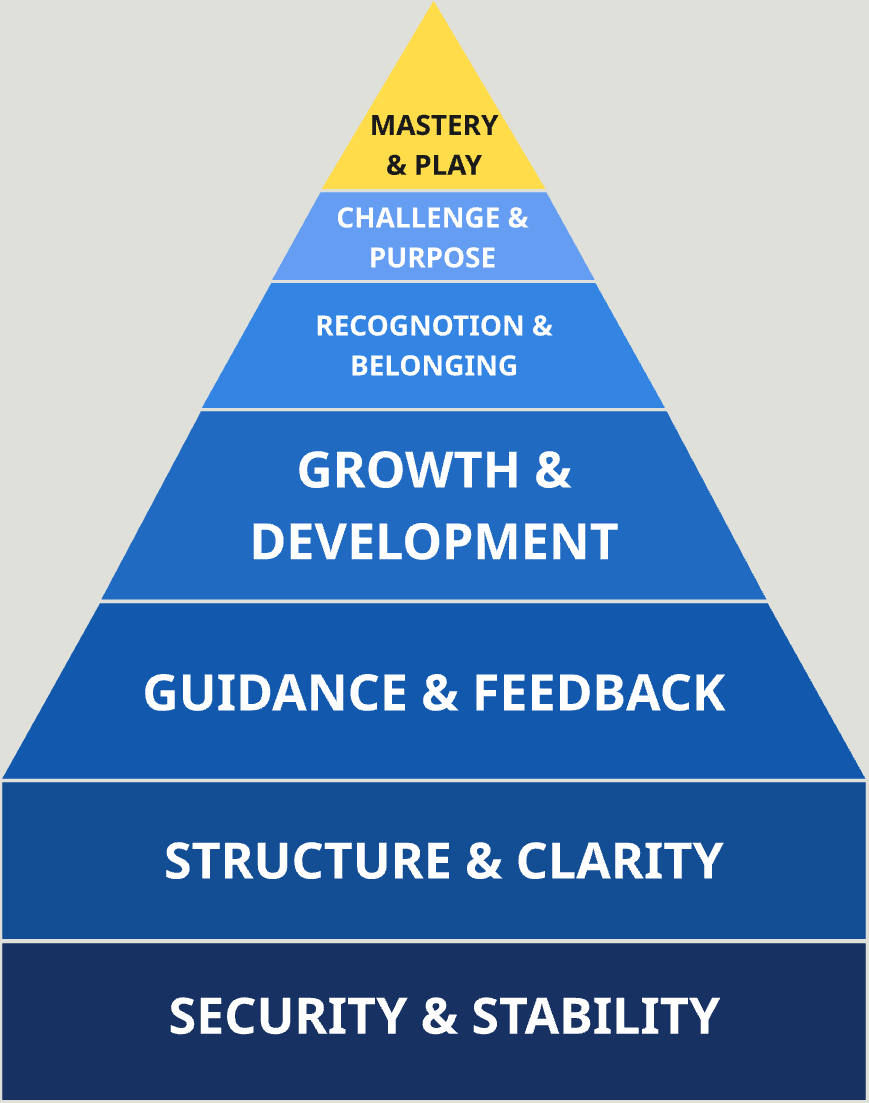The Employee Hierarchy of Needs
Every person comes to work with a set of needs, not just the need to earn money, but also the need to feel safe, to understand their place, to grow, and to be recognized. When companies overlook these layers, they end up with teams that are confused, burned out, or simply checked out. But when they build the workplace from the ground up, meeting each level of need before moving on to the next, they create strong, motivated, and loyal employees.
Imagine this as a pyramid, similar to Maslow’s hierarchy of needs, but focused on employees in the workplace.
1. Security and Stability
At the base of the pyramid is security, both financial and emotional.
If employees can’t pay their bills, afford healthcare, or trust that their job will still be there next month, nothing else matters. They will always be operating in survival mode.
Security includes:
Fair pay that matches their effort and cost of living.
Consistent hours or workload so they can plan their lives.
Safe, respectful work environments where people aren’t afraid of harassment, burnout, or being blamed unfairly.
This level is about creating a foundation where people can stop worrying and start focusing.
2. Structure and Clarity
Once security is met, the next need is structure. Employees need to know what’s expected of them, how their work fits into the bigger picture, and what success actually looks like.
Clarity includes:
Clear job descriptions and responsibilities.
Well-documented processes that prevent confusion.
Defined goals that connect to the company’s mission.
Accountability that shows the structure matters.
When people know what they’re supposed to do and why it matters, they waste less energy guessing and more energy improving. Structure gives creativity shape.
3. Guidance and Feedback
After structure comes direction. Employees need regular feedback to understand how they’re doing. Not just annual reviews, it’s about consistent conversations.
Guidance includes:
Coaching from managers, not just supervision.
Measurement systems that track performance fairly.
Feedback loops that help employees adjust and grow.
Without feedback, people either assume they’re doing fine (and might not be) or they constantly worry they’re failing (when they’re not). Guidance creates confidence, the sense that someone is watching, noticing, and helping you get better.
4. Growth and Development
Once employees know where they stand, they start looking for how to grow. Development is the point where people begin to invest more of themselves, they want to learn new skills, take on new challenges, and see a path forward.
Growth includes:
Training beyond onboarding, deeper skill-building and cross-training.
Certifications or professional development that add real value to their careers.
Mentorship or opportunities to shadow senior employees.
When employees grow, the company grows too. A culture that encourages learning turns everyday work into a form of self-improvement.
5. Recognition and Belonging
At this level, people are connecting to a team. Recognition gives meaning to effort. Belonging turns a workplace into a community.
Recognition includes:
Celebrating achievements, large and small.
Building team rituals: weekly wins, shoutouts, shared celebrations.
Encouraging peer recognition, not just manager praise.
When employees feel seen and valued, motivation becomes self-sustaining.
6. Challenge and Purpose
Near the top of the pyramid, work becomes about purpose and impact. Employees who feel stable, guided, and valued start asking deeper questions: Does my work matter? Am I growing toward something meaningful?
Challenge and purpose include:
Stretch projects that let employees test their skills.
Autonomy to make decisions and shape their own path.
Alignment with company purpose - seeing how their daily work supports a larger mission.
When people understand the “why” behind their effort, their work becomes a source of pride and identity.
7. Mastery and Play
At the very top is a level few workplaces ever reach - where work feels like play. Not because it’s easy, but because it’s meaningful and engaging.
This level includes:
Gamification: point systems, badges, or progress milestones that make improvement fun.
Creativity and experimentation, space to try new ideas without fear of failure.
A sense of mastery, where employees feel not just competent, but excellent at what they do.
At this stage, employees become contributors, creators, and partners in the company’s success.
The Takeaway
Companies often try to jump straight to the top, adding gamification, culture perks, or slogans about “purpose”, before the basics are secure. But no one can play the game if they don’t feel safe, supported, and guided.
A strong workplace doesn’t start with perks. It starts with foundations: fair pay, clear roles, honest feedback, and real growth paths. Build those first, and everything else starts to take care of itself.
